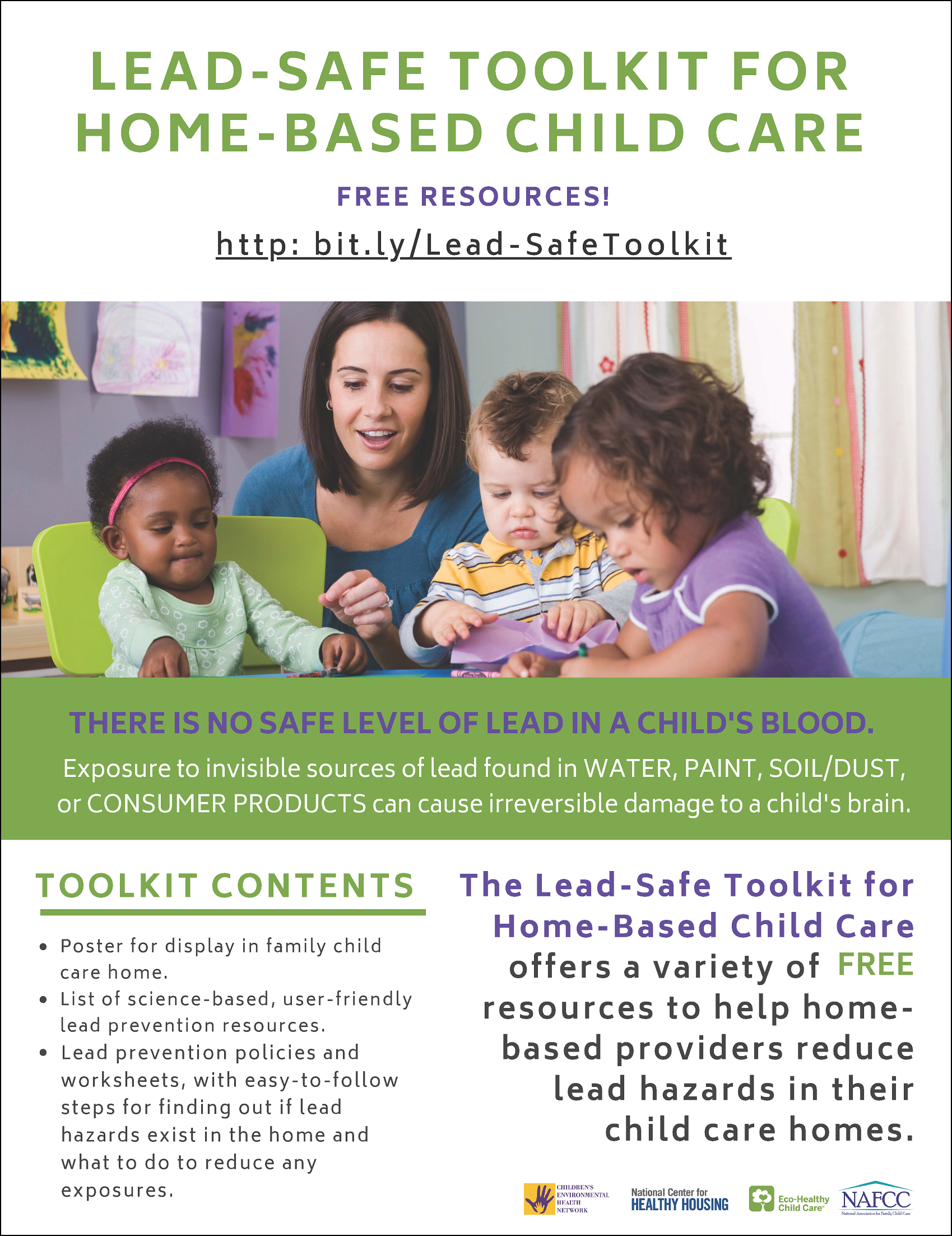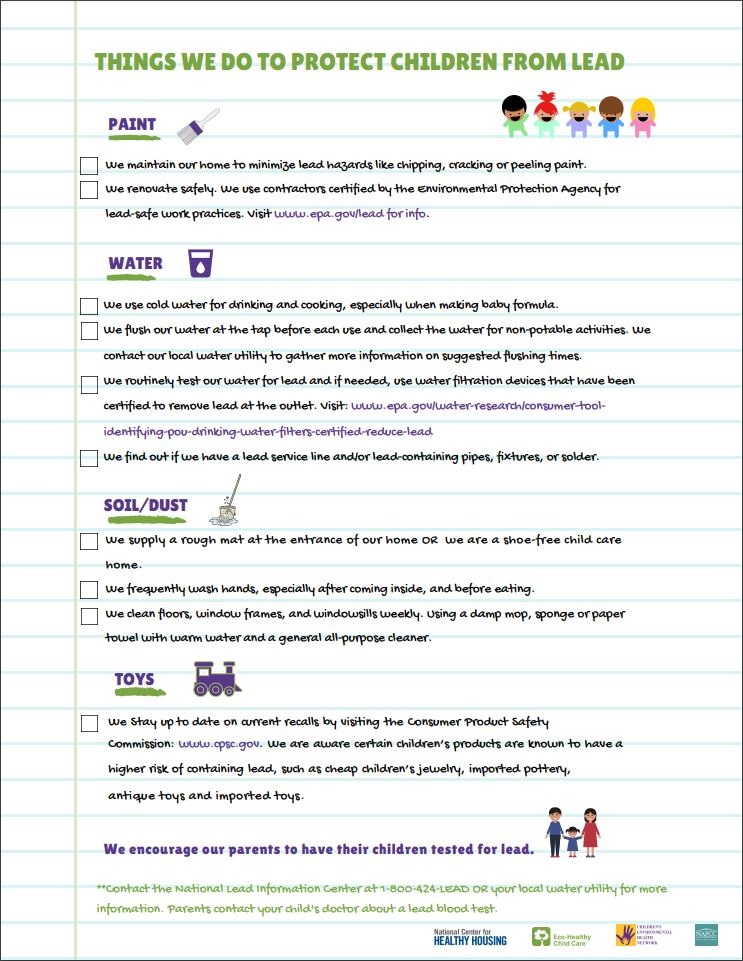Protecting Children from Lead Exposures in Child Care
Para la página en español, visite Protección de los niños contra la exposición al plomo en el cuidado infantil.
Project Funder: JPB Foundation
Project Partners: Eco-Healthy Child Care®, a national program of the Children’s Environmental Health Network (CEHN), and the National Association for Family Child Care (NAFCC)
Project Contacts: Eco-Healthy Child Care, ehcc@cehn.org; Zakenya Neely, zneely@nafcc.org, 202.796.5700 (main); Amanda Reddy, areddy@nchh.org, 443.539.4152
Project Description
In the United States, three million children under the age of six receive care in family home settings, by approximately one million home-based child care professionals, many of whom are unaware of possible lead dangers in their homes’ paint, dust, soil, water, and consumer products. There is no safe level of lead for children; even low levels of exposure to invisible sources of lead can cause irreversible damage to a child’s brain and nervous system, resulting in IQ deficits and learning and behavioral problems that last a lifetime. As harmful as these effects are, the good news is that lead exposure is preventable and lead hazards are fixable. The actions home child care providers take can make a big difference in the lives of the children they serve.
With funding from the JPB Foundation, Eco-Healthy Child Care (a national program of the Children’s Environmental Health Network), the National Association for Family Child Care, and the National Center for Healthy Housing have partnered to help child care providers eliminate lead in their home environments by developing the Lead-Safe Toolkit for Home-Based Child Care. Survey responses from nearly 500 home-based child care providers across the country, as well as a panel of lead poisoning prevention experts, helped us assess the most useful items to put into the toolkit. Child care providers are encouraged to use this toolkit to establish lead prevention policies for their businesses and learn vital lead prevention strategies for use in their child care homes. This toolkit was created for family child care providers with input from providers, and it offers a range of free and low-cost practices and resources to help providers reduce lead hazards in their child care homes.
Center-based professionals may also be unaware of lead hazards at their child care businesses; therefore, with additional funding from the JPB Foundation, Eco-Healthy Child Care (a national program of the Children’s Environmental Health Network), the National Association for Family Child Care, and the National Center for Healthy Housing also developed the Lead-Safe Toolkit for Center-Based Child Care.
Both home-based and center-based child care providers are encouraged to use these toolkits to establish lead prevention policies for their businesses and learn vital lead prevention strategies for use in their child care facilities.
The Lead-Safe Toolkit for Home-Based Child Care
The Lead-Safe Toolkit for Home-Based Child Care (HBCC) and Lead-Safe Toolkit for Center-Based Child Care (CBCC) contents include:
- Posters for display in child care homes and centers (HBCC | CBCC).
- Lead-in-paint policies (HBCC | CBCC) and accompanying worksheets (HBCC | CBCC) for homes built prior to the EPA’s ban on lead-based paint in 1978, with simple steps for determining whether paint could contain lead and actions to reduce exposure. Many of these steps are inexpensive and easy to implement.
- Lead-in-soil policies (HBCC | CBCC) and accompanying worksheets (HBCC | CBCC) for homes built prior to the EPA’s ban on lead-based paint in 1978, with simple steps for determining whether soil is potentially contaminated with lead and actions to reduce exposure. Many of these steps are inexpensive and easy to implement.
- Lead-in-water policies (HBCC | CBCC) and accompanying worksheets (HBCC | CBCC) with simple steps for finding out if water is potentially contaminated with lead and actions to reduce exposure. Many of these steps are inexpensive and easy to implement.
- Lead-in-consumer-products policies (HBCC | CBCC) and accompanying worksheets (HBCC | CBCC) with simple steps for determining whether certain consumer products could be contaminated with lead and actions to reduce exposure. Many of these steps are inexpensive and easy to implement.
- A collection of science-based, widely used lead prevention resources for both home- and center-based child care businesses (HBCC | CBCC).
Additional Resources
WEBINAR SERIES: In our four-part webinar series, you’ll learn how to protect the children entrusted to your care from lead hazards found in paint, water, soil, and consumer products. You don’t have to watch the webinars in order. Watch the series on YouTube:
COVID-19: For comprehensive guidance on cleaning, disinfecting, screening, social distancing and other COVID-19 best practices within child care environments, consult the Centers for Disease Control and Prevention (CDC) website. NCHH has also curated a page of resources to assist with the challenges created by COVID-19, including some that may be useful to home- and center-based child care providers. Please also be sure to consult your state and local reopening guidelines.
COMING SOON: Peer-reviewed articles, additional webinars and videos, press releases, and blog posts.
Latest page update: April 4, 2024.


